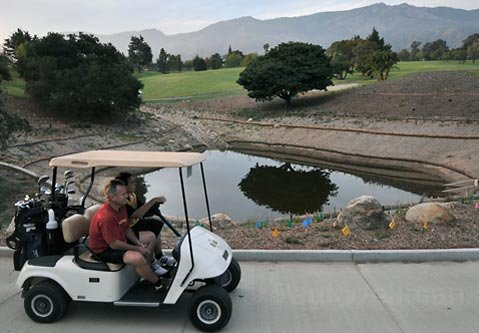More Lanes for Short-Haul Vehicles
How About a Test Drive on Earth Day Weekend?
My Tundra 4×4 is a fabulous machine for pulling a trailer, accessing high Sierra trailheads, or hauling kayaks up the coast. However, it becomes cumbersome and out of context downtown, it’s a barge in the Five Points parking lot, and it now refuses to enter the Trader Joe’s lot on De la Vina.
This truck has a little electric brother for local expeditions, but it goes 26 miles mph in a world of traffic signals set for 35 mph. It sneaks around on back roads to keep from bogging down automobile circulation. Santa Barbara lacks a short-haul traffic solution to reduce the need for local automobile use and to support mass transit as a viable alternative. The technology not only exists but has been tested and continues to develop. Let’s take a serious look at golf carts and hump-mobiles (human powered machines) to solve our in-city transportation needs.

Golf carts have stood the test of time under the most rigorous environmental conditions and driven relatively safely by people exhibiting the full range of human emotions and altered states of consciousness. They carry bags and friends with ease and can park in small spaces. Toss the Segway, electric scooters, wheelchairs, and new technology into this category and we have a wide range of non-polluting, low cost vehicles for short local trips.
Ranging from high tech to cornball, the Cabrillo bikeway offers a smorgasbord of human-powered rolling stock. Unfortunately all the Hump-mobiles—bikes, trikes, four-wheel surreys, rollerblades, skates, and scooters—are mixed up with power-walking talkers, baby strollers, gawking tourists, and iPod rockers. While that segment of the shoreline has become a dangerous environmental impact resort, it is still safer than the downtown area, where biking is reserved for the fearless, the clueless, or the carless. Alternative transportation does not mix well with cell phone laden SUVs and only a painted white line separating the two.
Traffic issues dominate planning discussions and many well-designed projects are trashed in hopes of somehow mitigating the increasingly ugly impact of too many cars. Unless automobile use is reduced concurrently with an increase in short-haul transportation use, we will be stuck in an infinite conversation loop that incorrectly frames the issue—as a need to widen 101 and increase parking fees, bulb outs, and busses.
The message here is that we lack the medium for making short trips using low-impact transportation alternatives. We have the technology, but very limited space to use it. Our community has spent untold hours planning, discussing, and dreaming up sustainable transportation schemes that have resulted in little change to our local circulation choices. But by playing with the plans, we can speed up urban evolution.
What we need is a temporary structure for mass participation and testing of our mobility options. In other words, a short-haul test drive.
Short-Haul Test Drive: For one weekend (Earth Day weekend?) close down one lane on State Street from the Arlington Theater to the pier and one lane on Cabrillo Boulevard from the Bird Refuge to SBCC—plus a few lanes on side streets. Invite locals to bring their hump-mobiles for a test drive and maybe a parade. Add some golf cart rentals to supplement those available on lower State.
All this should be done with orange cones and temporary barriers and without any economic pain or business disruption. The goal is to foster participation and provide a method for feedback and a forum for constructive criticism. We gather data and write the test-drive impact report the next week. Participants do the planning. We correct mistakes and plan Round Two.
Test Drive, Next Rounds: Expand the first test drive by adding more car-free lanes and increase the alternative transportation options and the time frame. Plan and advertise a Hump-Mobile Parade and Electric Cart Expo. Work with downtown offices and businesses to acquire golf carts for the week and allow staff to experience alternative ways to do lunch or get to the Courthouse. Again foster participation, feedback, and fun while building momentum for permanent community-enhancing alternatives to the car.
Finally, should we make State Street into a pedestrian mall or leave it for the cars? How about None of the Above? The pedestrians are on the brick sidewalks, or shopping, or eating; the cars are parked in the fabulous expensive garages; and State Street is teeming with golf carts and hump-mobiles.



